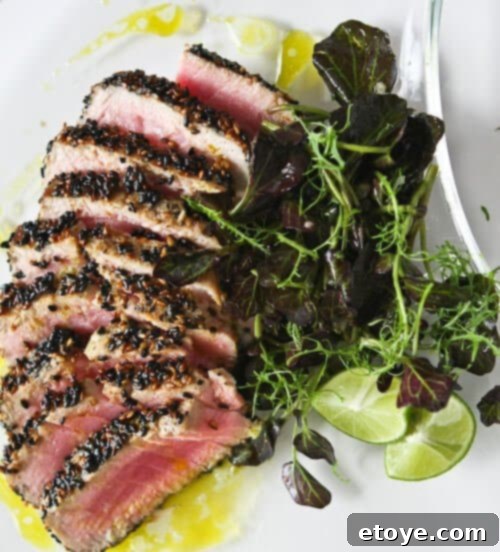
Embark on a culinary adventure that simplifies the art of cooking while elevating your dishes to gourmet standards. Today, we’re diving into the principles that transform ordinary meals into extraordinary experiences, inspired by the visionary work of Michael Ruhlman and his groundbreaking book, Ratio: The Simple Codes Behind the Craft of Everyday Cooking. This philosophy empowers home cooks to break free from rigid recipes, fostering an intuitive understanding of food preparation. Our featured dish, a dazzling Sesame Seared Tuna with a vibrant Lime-Ginger Vinaigrette, perfectly embodies this approach.
The genesis of this exquisite Lime-Ginger Vinaigrette didn’t involve meticulous recipe following. Instead, it was born from a fundamental culinary ratio and a quick glance into the refrigerator. Discovering a ripe key lime and a fresh nub of ginger, the path was clear. Armed with Ruhlman’s celebrated 3 parts oil to 1 part vinegar ratio for vinaigrettes, these simple ingredients were whisked into a bright, zesty concoction that perfectly complements the rich tuna. This is the magic of ratios: transforming available ingredients into balanced flavors with inherent understanding.
While the 3:1 vinaigrette ratio might be familiar to some, Ruhlman’s book unveils a universe of culinary formulas that demystify complex preparations. Imagine mastering Hollandaise sauce, perfect pizza dough, delicate crepes, savory sausages, effective brines, silky custards, luscious caramel sauce, fluffy pound cake, and tender biscuit dough – all through knowing their core ratios. With over 25 essential formulas, understanding these ratios is akin to unlocking a thousand recipes. It’s not just about memorizing steps; it’s about grasping the underlying architectural framework of cooking, allowing for limitless creativity and adaptation.
For those eager to transform their cooking, Michael Ruhlman’s book is an indispensable guide. You can purchase a signed copy directly from Michael Ruhlman’s website, allowing you to personalize your culinary journey with a special inscription. Alternatively, for a slightly more economical option, unsigned copies are available through Amazon. Whichever route you choose, acquiring this book is an investment in your culinary skill and confidence, promising to revolutionize your kitchen experience.
Insights from the Culinary Master: Michael Ruhlman
To further immerse yourself in Michael Ruhlman’s philosophy, I invite you to explore exclusive content where we delve deeper into his insights. Listen to my engaging podcast interview with Michael Ruhlman, where we discuss the profound impact of ratios on everyday cooking and beyond. This “steamy” conversation provides a personal glimpse into the mind of a culinary visionary, offering practical advice and inspiring anecdotes that will fuel your passion for cooking. Access the full podcast here: My Podcast Interview with Michael Ruhlman.
Additionally, witness Ruhlman himself elucidate the core concepts of his book in his insightful video presentation. This visual guide offers a clear and concise explanation of how ratios work and their transformative power in the kitchen, making complex ideas accessible to all. Watch Michael Ruhlman’s captivating video about his book, Ratio, to gain a deeper understanding: Michael Ruhlman on Ratio.
Precision in the Kitchen: The Indispensable Role of a Kitchen Scale
In the pursuit of culinary excellence, especially when embracing the precision of ratios, a kitchen scale becomes an indispensable tool. Michael Ruhlman himself champions the kitchen scale as one of his most essential pieces of equipment, and for good reason. The subtle variations in density and volume mean that measuring ingredients by weight, rather than cups or spoons, ensures unparalleled accuracy and consistency in your results. This is particularly crucial for baking, where even slight discrepancies can alter the texture and outcome of a dish, but its benefits extend to all forms of cooking.
Consider the difference: a cup of flour can weigh differently depending on how it’s scooped or sifted, leading to inconsistent batters and doughs. A scale eliminates this guesswork, providing exact measurements every time. This precision is fundamental to truly understanding and executing the “ratios” that Ruhlman advocates, as many professional recipes and ratio formulas are expressed in weight for optimal performance. Beyond accuracy, a good kitchen scale simplifies clean-up, often requiring fewer measuring cups and spoons.
Among the myriad of options, the Leifheit kitchen scale stands out for its thoughtful design and reliability.  I particularly admire its sleek, minimalist profile – it’s as thin as a magazine, making it incredibly easy to store and a stylish addition to any kitchen countertop. Its compact size belies its robust functionality, offering precise measurements for all your culinary endeavors. To celebrate the importance of this essential tool and inspire more home cooks to embrace precision, I’m thrilled to announce a giveaway! One lucky commenter will receive a Leifheit kitchen scale. To enter, simply leave a comment on the original post featuring my interview with Michael Ruhlman.
I particularly admire its sleek, minimalist profile – it’s as thin as a magazine, making it incredibly easy to store and a stylish addition to any kitchen countertop. Its compact size belies its robust functionality, offering precise measurements for all your culinary endeavors. To celebrate the importance of this essential tool and inspire more home cooks to embrace precision, I’m thrilled to announce a giveaway! One lucky commenter will receive a Leifheit kitchen scale. To enter, simply leave a comment on the original post featuring my interview with Michael Ruhlman.
Mastering Sesame Seared Tuna with Lime Ginger Vinaigrette
Now, let’s turn our attention to the star of our culinary show: a perfectly executed Sesame Seared Tuna, brightened by our homemade Lime-Ginger Vinaigrette. This dish is not only a feast for the eyes but also a testament to how simple techniques and fresh ingredients can yield restaurant-quality results at home. It’s a lean, flavorful, and incredibly satisfying meal that comes together quickly, making it ideal for both weeknight dinners and special occasions.
Step-by-step photos: How to create the perfect Sesame Seared Tuna
The journey to an impeccable seared tuna begins with meticulous preparation and a touch of artistic flair. You’ll need two beautiful pieces of fresh tuna, a potent wasabi paste, and a shallow bowl filled with sesame seeds. While using a single color of sesame seed is perfectly fine, a blend of black and white seeds adds a striking visual contrast, making your dish even more appealing. Begin by thoroughly patting the tuna fillets dry with paper towels. This crucial step removes excess moisture, ensuring a crisp, golden crust when seared:
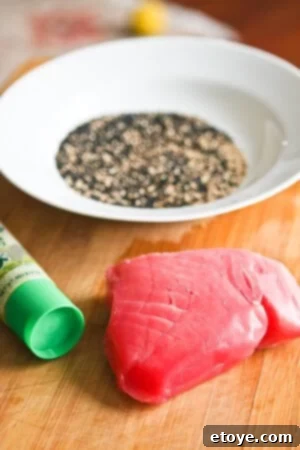
Next, it’s time for the wasabi. Instead of diluting wasabi into a soy sauce mixture, which often results in an overpowering kick, I highly recommend smearing a thin layer directly onto both sides of the tuna. This method allows the wasabi’s pungency to mellow beautifully during cooking, infusing the tuna with a subtle, aromatic heat that enhances its flavor without overwhelming it. Trust me, the difference is remarkable. Feel free to adjust the amount of wasabi to your personal preference for heat:

With the wasabi applied, season your tuna generously with salt and freshly ground pepper. I particularly favor using a good quality sea salt, as its coarser texture and nuanced flavor provide a superior seasoning experience compared to standard table salt. The combination of wasabi, salt, and pepper forms the foundational seasoning layer for our seared tuna, preparing it for the flavorful sesame crust:
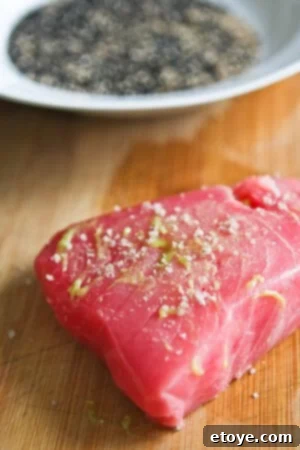
Now for the sesame seed coating. Gently press each side of the tuna fillet into your shallow bowl of sesame seeds, ensuring that all surfaces, including the thin edges, are thoroughly coated. This creates a beautiful, textural crust that becomes golden and fragrant when seared. The visual appeal of the mixed black and white sesame seeds truly makes this dish pop, but any sesame seeds will contribute to a delicious and satisfying crust:
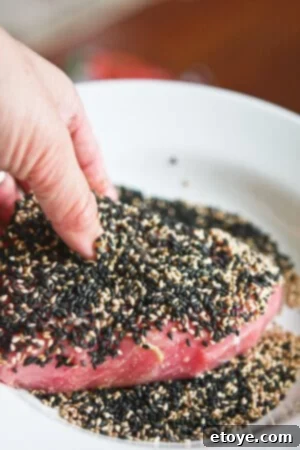
The searing process is critical for achieving the perfect balance of a crispy exterior and a tender, rare interior. Heat a frying pan over medium-high heat, adding a tablespoon of cooking oil. The key here is not to use super-high heat, as this will quickly burn the delicate sesame seeds, resulting in a bitter, unappetizing taste. Aim for a heat that allows the white sesame seeds to turn a beautiful golden brown without scorching. Cook the tuna for approximately 2 minutes per side, then briefly sear the thinner edges for about a minute each to ensure full coverage and a consistent crust. The image above captures the tuna just before it was perfectly pulled off the pan, showcasing an ideal sear.
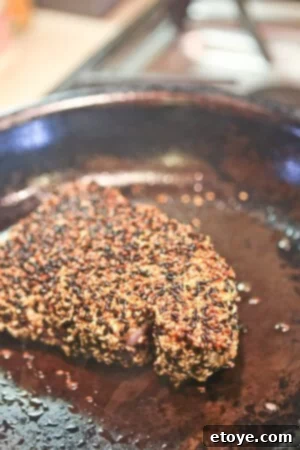
Perhaps the most vital instruction: do not overcook the tuna! The hallmark of perfectly seared tuna is a beautifully browned crust with a vibrant, raw-to-rare center. While individual preferences for doneness vary, preventing the fish from becoming dry and tough is paramount. You can discreetly make a small incision into the thickest part of the fillet with a knife to check its progress. Remember, tuna continues to cook slightly after being removed from the heat, so err on the side of undercooking if you prefer a rarer finish.
For the exquisite Lime-Ginger Vinaigrette, selecting the right oil makes a significant difference. I wholeheartedly recommend the avocado oil from Earthy.com. This oil is a revelation – rich, buttery, and boasting a vibrant avocado-green hue. Its high smoke point also makes it versatile, but its flavor truly shines in salad dressings. If avocado oil isn’t readily available, a high-quality extra virgin olive oil makes an excellent substitute, imparting its own distinctive fruity notes to the vinaigrette.
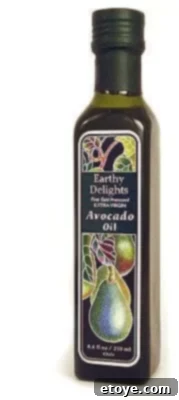
Once the tuna is perfectly seared and rested, and your vibrant vinaigrette is prepared, the final presentation awaits. Slice the tuna against the grain into beautiful thin pieces, showcasing its perfectly seared exterior and succulent, rare interior. Arrange these slices artfully on a plate, then generously drizzle with the zesty Lime-Ginger Vinaigrette. For an added touch of freshness and a complete appetizer, toss some crisp salad greens with the remaining vinaigrette and serve alongside the tuna. This dish is a harmonious blend of textures and flavors – a true culinary triumph.
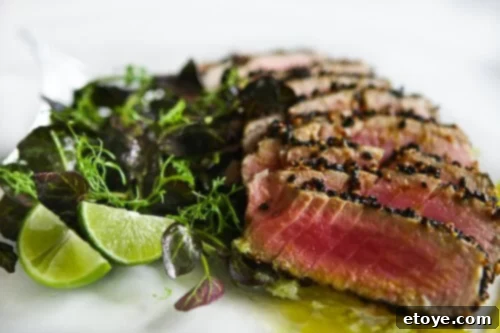
Sesame Seared Tuna with Lime Ginger Vinaigrette Recipe
This elegant and flavorful dish celebrates fresh tuna perfectly seared with a sesame crust, complemented by a bright and zesty lime-ginger vinaigrette. The vinaigrette itself is a testament to the power of culinary ratios, following the classic 3 parts oil to 1 part acid. For the oil component, options are versatile, ranging from the rich, buttery notes of avocado oil to the fruity depth of olive oil, or neutral vegetable and grapeseed oils. The acid can be fresh lime or lemon juice, or various vinegars like balsamic or rice vinegar, allowing for delicious customization. This recipe makes an excellent main course or a sophisticated appetizer that is sure to impress.
Serves: 4 as an appetizer, 2 as a main course
Prep time: 15 minutes
Cook time: 6-8 minutes
Ingredients:
- 3 tablespoons black sesame seeds
- 3 tablespoons white sesame seeds
- 2 pieces fresh tuna fish fillet (approximately 1 pound total, about 1-inch thick)
- 1 teaspoon wasabi paste (or to taste)
- 1 tablespoon cooking oil (e.g., canola, grapeseed, or avocado oil with a high smoke point)
- Salt and freshly ground black pepper, to taste
For the Lime-Ginger Vinaigrette:
- 1 tablespoon freshly squeezed lime juice (from about 1 key lime or half a regular lime, or other vinegar of choice)
- 1 teaspoon finely grated fresh ginger
- 3 tablespoons avocado oil (or a good quality olive oil, grapeseed oil)
- Pinch of salt
- Pinch of freshly ground black pepper
Optional for serving:
- 2 large handfuls mixed salad greens
Instructions:
- Prepare the Sesame Coating: In a shallow bowl, combine the black and white sesame seeds. Set aside.
- Prepare the Tuna: Pat the tuna fillets very dry on all sides with paper towels. This is crucial for a good sear.
- Apply Wasabi: Smear a thin, even layer of wasabi paste on both sides of each tuna fillet.
- Season the Tuna: Season the wasabi-coated tuna generously with salt and freshly ground black pepper on all sides.
- Coat with Sesame Seeds: Gently press each tuna fillet into the bowl of sesame seeds, ensuring all surfaces, including the thin edges, are completely coated.
- Heat the Pan: Heat a large frying pan or cast-iron skillet over medium-high heat. Add the 1 tablespoon of cooking oil. When the oil is shimmering and just beginning to smoke slightly, it’s ready.
- Sear the Tuna: Carefully place the tuna fillets into the hot pan, ensuring they are not touching. Cook for exactly 2 minutes on the first side until a golden-brown crust forms.
- Flip and Continue Searing: Flip the tuna fillets and cook for another 2 minutes on the second side.
- Sear the Edges: Using tongs, carefully sear each of the thin sides of the tuna for approximately 1 minute each, ensuring a crisp crust all around. Monitor the sesame seeds closely to prevent burning; if they start to darken too quickly, slightly reduce the heat.
- Check Doneness & Rest: Remove the fish from the pan to a clean plate. The center should be rare to medium-rare. If you prefer it more done, continue cooking for short increments, but be careful not to overcook, as tuna can quickly become dry. Let the tuna rest for 2-3 minutes before slicing.
- Make the Vinaigrette: While the tuna rests, whisk together the lime juice (or vinegar), grated ginger, and avocado oil in a small bowl until well combined and slightly emulsified. Season with a pinch of salt and pepper to taste.
- Serve: Slice the rested tuna into thin, uniform slices (about ¼ inch thick) against the grain. Arrange the slices artfully on individual plates. Drizzle a generous amount of the Lime-Ginger Vinaigrette over the tuna. If desired, lightly toss the optional salad greens with the remaining vinaigrette and serve alongside the tuna.